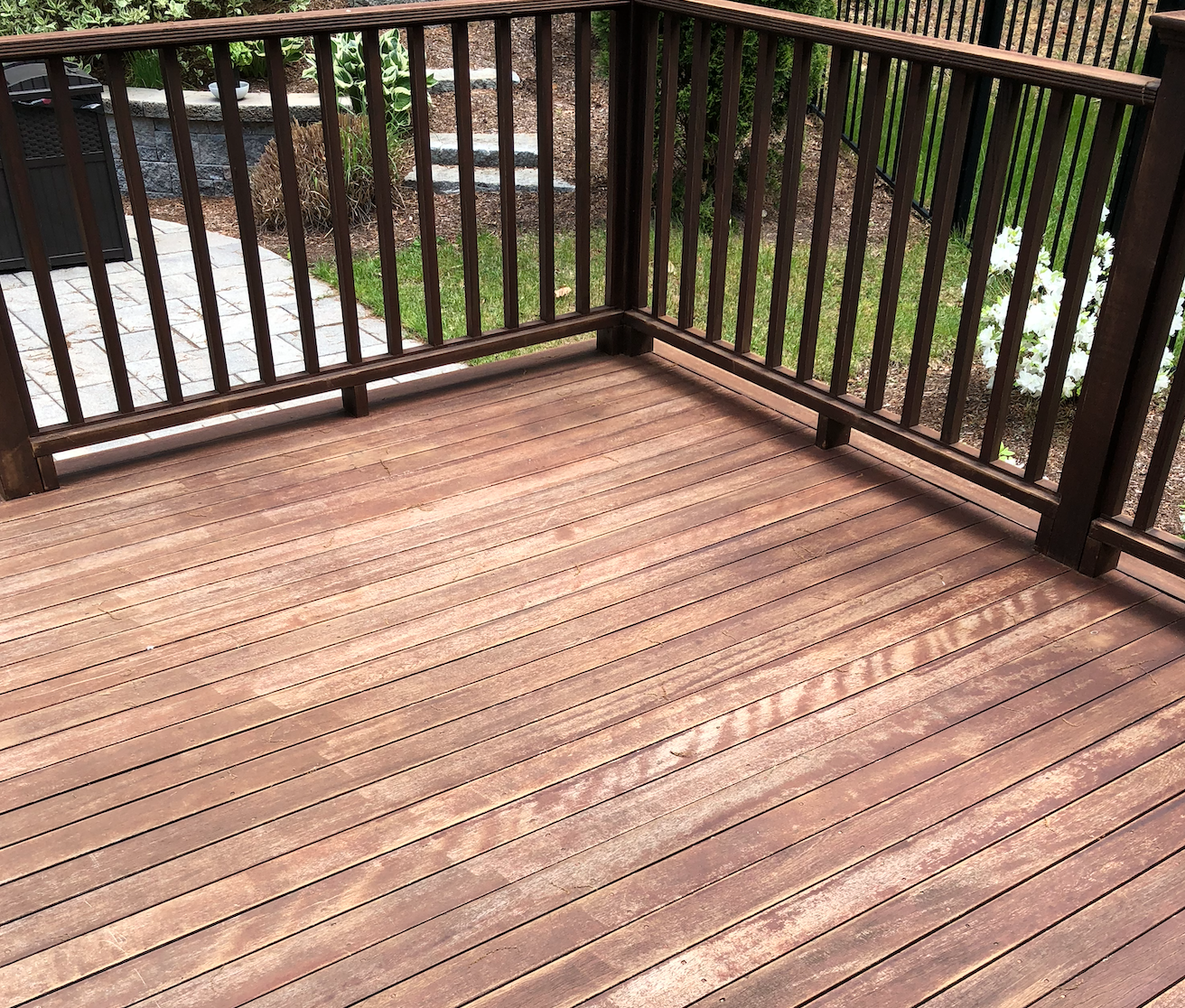
How long will the stain on my deck last?
Posted on June 6, 2024
Key takeaways from this article:
- Staining a wood deck should occur frequently (every 1-2 years) – especially on horizontal surfaces like the floorboards and steps.
- The stain wears away quickly on floorboards and steps because of three factors: 1. Sun 2. Foot traffic 3. Water
- The railings and vertical surfaces will need staining much less often because they are vertical and shed water quickly due to gravity.
- If you have the choice, choosing a material like Trex will cost you more in the short run but will bring your maintenance costs to almost $0.

“Why does my deck look worn when I just stained it last year?”
Wood decks’ ongoing maintenance is a common complaint among homeowners. You (or your professional painter) are not doing anything wrong if this happens to you; it’s just a confluence of factors that make deck tops very hard to keep looking good. Let’s dig in.
The following are the reasons that your deck top looks faded and worn after only a year:
1. Sunlight fades deck stains.
The more the hot sun beats down on your deck top, the more often you’ll need to restain it. You can really notice this phenomenon when you look at the dark, unfaded stain underneath chairs and grills that shaded it from the sun compared to the areas that the sun hits daily.
2. Water from rain and snow seeps into the deck top (floorboards).
Because the deck top is horizontal, water does not “shed” as easily as it does on vertical surfaces like the deck rails. This is why, after about a year, you’ll notice your deck rails still look dark while the deck top is already fading. Gravity works well on vertical surfaces like railings or the side of your home to shed water. Still, horizontal surfaces don’t benefit from gravity and water puddles and stick around a lot longer on deck floorboards, degrading the stain and putting your deck at risk for rot.
Once you notice the stain fading, you’re losing the protection the stain provides against the wood rotting, so restaining is a must.
If you fail to restain in time, you will notice wood rot (especially near corners and edges that hold water longer). These boards need to be replaced before you stain them again. You do not have to replace all of the deck boards, just those that are rotted.
Climate plays a significant role in deck maintenance. In areas with harsh winters or hot summers, the deck’s exposure to extreme weather (both sun and cold) can accelerate wear and tear. Using protective covers, building pergolas, or adding shade can mitigate some of these effects and prolong the life of your stain.
3. Foot traffic wears the stain off:
Because the deck top receives foot traffic, the stain wears off quickly.
3 ways to make sure your deck looks nice and stays protected:
1. Restain your deck top every 1-2 years (cost $700-1,500 for average-sized decks stained by a professional. Much less if you DIY the project)
This is the least expensive option in the short term and the most expensive in the long term, as you will need to restain your deck’s top almost yearly. While a DIY project is less expensive it will come with the one-time cost of additional tools you’ll need for the job.
2. Re-do your deck with composite material like Trex (cost: $ 7,000+ for average decks by a professional, less if you DIY the project).
You can keep the structure underneath and replace the horizontal deck top with Trex or a similar composite product. This option will prevent yearly maintenance. Composite decking is incredibly durable and can withstand many years of use with little or no maintenance or degradation.
3. Replace our wooden deck with a stone/paver patio.
This is only an option for decks near the ground. This is likely the most expensive option with the least amount of yearly maintenance.
Types of stains:
Stains come in various types, each offering different levels of protection:
- Transparent stains highlight the wood’s natural grain but require more frequent applications.
- Semi-transparent stains provide a balance of color and wood grain visibility.
- Semi-solid stains offer a balance between semi-transparent and solid stains, providing more protection but less visibility of the wood grain.
- Solid stains offer the most protection and color uniformity but hide the wood’s natural look and grain.
Choosing the right stain can impact your deck’s maintenance schedule.

About the author: Paige NeJame is the owner of CertaPro Painters of the South Shore, South Coast, Plymouth, and Boston, Massachusetts areas. She is a national contributor to many publications, including Forbes, Martha Stewart, Apartment Living, BobVila.com, and many others. She has been in the painting business since 2004, and her company has painted 20,000 projects over the years.





